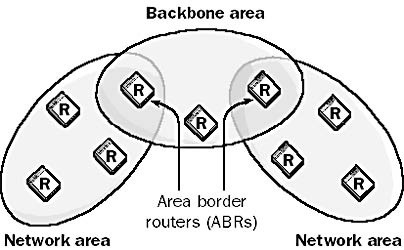Definition of Open Shortest Path First (OSPF) Protocol in Network Encyclopedia.
What is Open Shortest Path First (OSPF) Protocol?
OSPF stands for Open Shortest Path First, is a link state routing protocol that is used to exchange routing information between dynamic routers. Open Shortest Path First (OSPF) is an Interior Gateway Protocol (IGP) that is used mainly in larger TCP/IP internetworks and within autonomous systems of the Internet. OSPF is more efficient in terms of network overhead than the Routing Information Protocol (RIP), but it is considerably more complex to plan and implement in an enterprise.
How OSPF Work?
OSPF-enabled routers use the Shortest Path First (SPF) algorithm to compute the shortest path between nodes on an internetwork. They create a map (or tree) called the link state database that describes the topology or structure of the router’s specific network area. Network areas are groups of networks connected using OSPF-enabled routers that all have router interfaces for any of the networks included in the area.

Areas typically have no more than about 30 or 40 routers and are connected to each other through a designated high-speed contiguous backbone area using area border routers (ABRs). OSPF areas simplify computation of link state information because the computational requirements of calculating link state information rise rapidly as the size and complexity of the network increase. With OSPF areas, each router need to maintain only link state information about its own area and other areas connected to it, which improves the scalability of OSPF.
The link state information stored in the database (routing table) of each router includes cost information in addition to hop information. Administrators can configure routers in a complex mesh topology network so that specific paths are preferred over others. The SPF algorithm is used so that routing information can be quickly recalculated if routers are moved or if they go down. This feature is known as Fast Convergence. The SPF algorithm also ensures that the routing tables contain the shortest (least-cost) paths and that routing loops do not occur.
The link state database of routing information is updated by advertisements using multicasting if a router goes down or if the structure of the network is reconfigured, and the database is used to calculate routes for delivering data over the network. Unlike the older RIP, OSPF uses multicasting to update only routing information, not the entire routing table. And unlike RIP-enabled routers, which broadcast routing information every 30 seconds, OSPF broadcasts changes only when they occur.
These features substantially reduce inter-router network traffic compared to RIP and make OSPF a more efficient protocol than RIP for large internetworks.
Designing OSPF-based internetwork
When you design an OSPF-based internetwork, you should work from the top down – that is, you should first plan your autonomous system and how it will interact with other autonomous systems, and then you should subdivide the autonomous system into areas and then into individual networks.
Try to map your IP address space and subnets to this hierarchy of areas and networks and assign each area a small set of network IDs that can be summarized as a small series of routes. Be sure that areas connect to each other through your high-speed backbone area and not directly to each other. (In other words, avoid back doors.) Specify cost values that relate to the amount of traffic and hardware characteristics of each router.